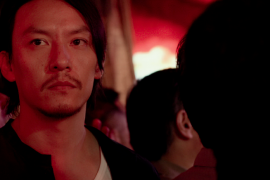Aleksandra recently watched ‘Reaching for the Moon’ - a film on the Brazil period of poet Elizabeth Bishop. These are her thoughts on poets in contemporary films.
Directed by Bruno Barreto, 2013, 118 min.
“Do not become a poet. Poets live a tragic life.” This is a sentence someone once said to me. I do not remember who said it, but the questions behind it remained while I was immersed in my own poems.
In times of suffering, love, madness and occasional happiness, a poet expresses all forms of feelings with heartfelt sentences. Words are chosen with a hidden agenda. They aim to discover the unknown. The words of a true poet can be magnificent and powerful.
But what is the source of this magic and power? Is it the tragedy of life? Is it the tragedy or the talent that creates the brilliance? Is the talent necessary to express the tragedy? Or is the tragedy needed to reveal the true talent? What was first, the tragedy or the poetic talent? For me, this is another example of the chicken or the egg dilemma. Still looking for answers, I came a across a cinematic artwork giving me a hint of a way out of this dilemma.
One of my favourite poets – Elizabeth Bishop – has recently been featured in the film ‘Reaching for the Moon’. This underappreciated film about the Pulitzer Prize-winning poet and her tragic love affair with Carlota de Macedo Soares – creator of Rio de Janeiro’s iconic Flamengo Park, shows much about the life of a poet. It shows the urge to live, to enjoy life, to travel and to find a place to call home. Yes, you read right, Bishop was also a lesbian, but – without trying to spoil the movie – the film does not focus on their sexual relationship or a rakish lesbian love tragedy. Instead it focuses on the struggle of life and ways to cope with them through the arts. In many ways the film reminded me more of the tragic love life of poet John Keats in ‘Bright Star’ rather than on a lesbian relationship like in ‘Blue is the Warmest Color’.
Sexuality is not an issue in ‘Reaching for the Moon’. You know it happens between the scenes, but lacks importance for the plot. What is more interesting in this film is the life of this poet; how tragedy of life inspires a writer to be poetic; and how poems can save shy and sensitive people from going mental. Due to the simplistic way to exemplify how tragedy affects and aggravates creativity, I very much enjoyed the film. If you want to see lesbian sex scenes between mature women, you will be disappointed with this film. Wanting to see cinematic artwork on the life of poets should be the goal when watching this film.
Clearly, one without the other would not exist. A true poet needs both talent and tragedy. The best art is made in tragic times. Suffering, madness and deprived love can cause creativity that goes beyond human imagination. In moments of pain the ideal saviour seems to be the channel of artistic enunciation. The talent to express this emotional turmoil with words can become an amazing catalyst. For me, poetry is nothing more or less than a catalyst. Elizabeth Bishop was able to survive financially, socially and mentally through this catalyst. Her early recognition as a poet makes her luckier but still no less tragic than unknown poets.



